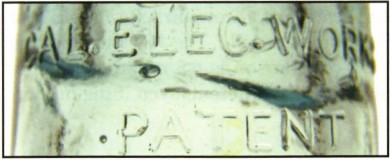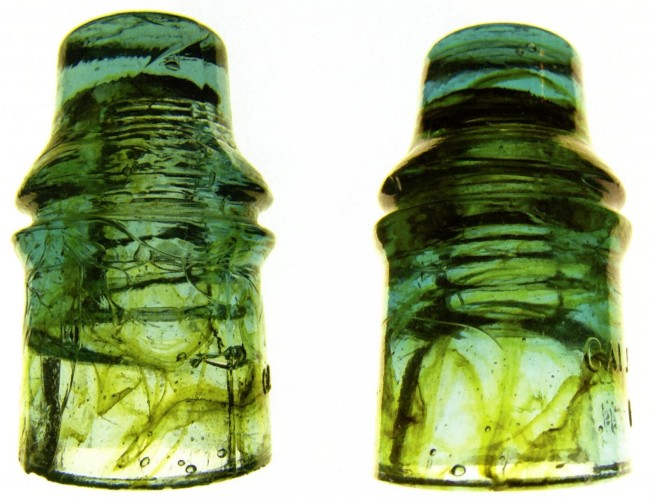Insulators of the California Electric Works
Reprinted from "Crown Jewels of the Wire", January 2006, page 21
Surprisingly, insulators bearing the name "Cal Elec Works", or
C.E.W., haven't been studied to the degree insulators manufactured by or for
other companies have.
Most collectors are aware of the A, B, C, etc mold designations for CD 123
EC&M insulators. In fact, many collectors nowadays can identify the
different EC&M mold styles at a glance.
Not so many people are aware of the differences in mold styles of the CD 130
Cal Elec Works insulators.
McDougald's price guide lists two mold styles. The (005) embossing style is
for a three-part mold; while the (010) mold style is for those insulators
bearing a mold line over the dome (MLOD). Anyone who handles very many CD 130's
will notice that the embossing is different on some than on others.
After looking at dozens of CD 130 insulators over the years, I've observed
that there are a at least seven major mold styles. While this article describes
those differences, it doesn't intend to imply that that's all there are. There
very well could be others I just have not happened across yet.

Here's a busy CD 130: graphite
plume in dome, numerous
bubbles, amber streaks
milk swirls and green in color!
Why haven't they been studied and written about like Hemingrays, or
EC&M's or California's? I'd suggest two reasons. 1) Supply. CD 130's aren't
as numerous as some other CD's. At the Western Regional Insulator Show in 2003,
for instance, I am aware that only one CD 130 was placed on a table for sale.
EC&M's, in contrast, were present by the dozens. 2) Uniformity. Some
collectors think one CD 130 looks pretty much like another.... standard ho hum
blue aqua. In this article, I hope to show that, while uncommon, there are some
outstanding varieties of CD 130's.
Large, Medium, Small
The first step in sorting mold varieties in CD 130's is to separate those
that have a mold line over the dome for those that don't. After that, even
Goldilocks can figure it out. There's a mold with large embossing (tall
letters), a mold for medium sized embossing, and a mold for small embossing
(short letters) for CD 130's that have a mold line over the dome; and there's a
mold with large embossing (tall letters) a mold for medium sized embossing and a
mold for small embossing (short letters) for CD 130's made in a three-part mold.
Additionally, there's a second mold for large embossing (tall letters) for the
three-part mold.
Mold Line Over Dome Varieties
 |
Mold Line Over Dome,
Small Sized Letters |
 |
Mold Line Over Dome,
Medium Sized Letters |
 |
Mold Line Over Dome,
Large Sized Letters |
On varieties with mold line over dome, small sized letters... the words Cal
Elec Works are 70 millimeters longs, while the word Patent is 34 millimeters
long.
On varieties with mold line over dome, medium sized letters, the words Cal
Elec Works are 68 millimeters long, while the word Patent is 31 millimeters
long.
On varieties with mold line over dome, large sized letters, the words Cal
Elec Works are 73 millimeters long, while the word Patent is 36 millimeters
long.
Three Piece Mold Varieties
Differences between the height of the letters is even more dramatic in the
three piece mold CD 130's.
 |
Three Piece Mold,
Small Sized Letters |
 |
Three Piece Mold,
Medium Sized Letters |
 |
Three Piece Mold,
Large Sized Letters,
Type One
(Note position of last 'T'
under "WO" of Works) |
 |
Three Piece Mold,
Large Sized Letters,
Type Two
(Note position of last 'T' directly under "W" of Works) |
On three piece mold varieties, small sized letters... the words Cal Elec
Works are 68 millimeters long, while the word Patent is 31 millimeters long.
On three piece mold varieties, medium sized letters... the words Cal Elec
Works are 73 millimeters long, while the word Patent is 37 millimeters long. '
On three piece mold varieties, large sized letters, type one, the words Cal
Elec Works are 76 millimeters long, while the word Patent is 36 millimeters
long.
On three piece mold varieties, large sized letters, type two, the words Cal
Elec Works are 73 millimeters longs, while the word Patent is 32 millimeters
long.
Letter Heights
Taking an overview of all the embossing is the best way to determine the
differences between the CD 130 varieties, as the height of individual letters is
sleight when measured. The "P" on the small letter, mold line over
dome variety is a mere 5 millimeters tall. The "P" on the large
letter, three piece mold variety by comparison is 6.5 millimeters high. Your eye
tells you the two are significantly different, even if the numerical values are
not.
Tall versus Short
Moving beyond the size of the letters, let's consider the size of the entire
insulator. Like CD 123 EC&M's, the height of the insulator was dependent
upon how much molten glass was placed in the mold. If the factory worker placed
too much glass in the mold, the insulator came out very tall. Too little glass
resulted in a short CD 130. The differences appear dramatic in the following
pictures. Notice the word "Patent" barely shows on the
"punk". By the way, both of these are mold line over dome varieties.

Amber Swirls
Both mold line over dome and three piece mold varieties can be found with
fabulous amber swirls. Shown below are photographs of individual insulators that
we believe have never before been published in Crown Jewels:

CD 130's with outstanding swirls don't come up for sale very often. The mold
line over dome variety on the left was purchased in an auction a few years back
for a price less than what you'd pay nowadays for a decent aqua.
The three piece mold style shown on the right came from a decades old private
collection, at four times the expense of the item to its left. Cal Elec's with
this much amber are extremely rare. Our honest advise is never pass up the
chance to purchase one.
Such Crudeness!

A large number of CD 130's have concave sides. It appears as if someone at
the factory grabbed the still hot and soft insulators with a pair of metal tongs
to remove them from the mold and/or place them on an annealing rack.
The picture above is an extreme example. Don't plan on measuring the length
of embossing on an insulator like this. With squished-in sides, the lettering is
all out of alignment.
Editor's note: Insulators shown in this article are from the collections
of Bob Jackson and Howard Banks.
Color printing is provided through a grant by Tommy Bolack.
We'll feature CD 120's made for Cal Elec Works, both embossed and unembossed
varieties, in a future article.
Story Telling Time
Like all classic insulators, CD 130's come with some fantastic stories
regarding their discovery. We'll mention a few in this article. The first is the
kind of adventure every collector dreams about. For one insulator hunter, the
dream came true.
There are a few Cal Elec Works insulators around that are dead mint. They
appear to never have been used. And, indeed, they may not have been. While we
can't confirm details of the story, several folks I know claim to have talked to
the source and say its true. It seems a collector was hunting insulators along a
railroad line in either Eastern California or Nevada many, many years ago. As he
walked underneath a railroad bridge, he spied a wooden box stowed away under the
timbers. Inside were a couple dozen CD 130's, never used and in as good
condition as the day they were made. The insulator shown below is reputed to be
from that find. There's absolutely no sign of wear. All the ones I've seen from
the find have all been three piece mold varieties. Some feature the small sized
embossing, and some medium sized lettering. All have been light aqua or ice aqua
in color.

More Great Stories
In the 1960's, a lot of CD 130's were found in the more urban areas. Greg
Bickford was an office employee for a telephone company. He talks about
borrowing a company ladder truck during his lunch hours to take down Cal Elec
Works insulators. He says they seemed plentiful enough that if they had any
visible damage he didn't waste his time removing them from service.
Believed to have been produced during the 1880s, CD 130's were used on some
of the early telegraph and railroad lines in the American West. Bottle hunters
stumbled across one line out of The Dalles, Oregon in the 1960's. The poles had
all rotted away, and the bottle collectors pulled up wire from the ground to
find insulators still attached. Perhaps five dozen CD 130's were recovered from
that line, including a few with heavy amber swirls. One was featured as
"Insulator of the Month" in the August 2004 issue of Crown Jewels.

Generally, when an insulator gets "sandblasted" by wind and
blowing sand, the result is not too attractive. But the elements polished this
specimen to an attractive "satin" finish.
CD 130.1's
Cal Elec Works insulators with fluted sides (CD 130.1) are rare in any color;
with aqua specimens harder to come by than cobalt ones.
Many of the cobalts that were found were recovered from the famous
"Ridge Line", the first long distance telephone line constructed in
the United States. The line provided communications for a company that sold
water to gold mines in central California.
At least one collector who worked the line, and found a cobalt CD 130.1,
believes the Cal Elec Works insulators were replacements for CD 123 EC&M's.
He noted that a forest fire had burned through the area after the line was
originally built, and his 130.1 came from where the flames had ravaged the
original line.

Are there more than one embossing variety for the CD 130.1's? There could be.
In all honesty, they are so scarce I've never had an opportunity to compare
multiple examples at once.


A common characteristic of CD 130's are "graphite plumes" which
appear in the dome glass. Speculation varies, but some suggest the
thread-forming mandrel was coated with a chemical to make it easier to remove.
When in contact with molten glass, the chemical may have formed a brief cloud of
gas that remained frozen forever in the insulators when they cooled. The top
picture is from a mold over dome variety, while the bottom is a three piece
mold.
Hope you enjoyed this introduction to CD 130's.
Howard Banks
| 